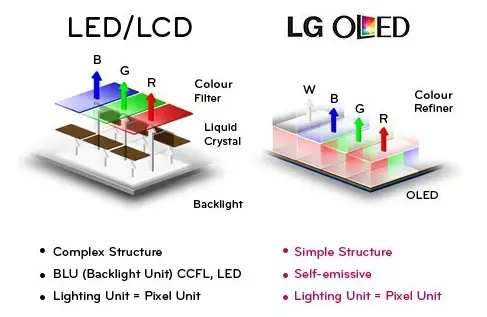What is technology LCD, LED, OLED comparison
Development of LCD TVs in the following way, first developed LSD then TVs LED LCD, following the latest technology televisions c OLED screens.
LCD vs LED screen
LCD screen
It’s pretty thin panel about 15mm consisting of several layers of one of the layers of liquid crystals is that when supply voltage change their structure and polarized light passing through them from the full bandwidth is not black to white, depending on the quality of an LCD panel depends on color reproduction and brightness of the picture . It can be easily seen if we compare cheap TVs and televisions leading manufacturers, while increasing the brightness on the bad quality of the picture is lost matrices on the more expensive the brightness is increased without loss of quality. Since LCD crystals do not produce light in order to see the image through the matrix to skip the light as a light source in LCD TVs use a lamp, they are placed behind the screen. There are several types of LCD matrix:
LCD – outdated technology in 2019, LCD TVs are practically not produced.
LED screen
This is the same as the LCD only uses LED backlight. If you delve into the technology have no much difference. But manufacturers as a marketing move vigorously promote and advertise LED technology, they have a number of advantages thanks to which ousted the backlight lamps, they are:
- Cheaper to manufacture (though manufacturers claim the opposite), but vacuum device to do more. And LCD production technology such that the lamp is built into the matrix in the event of damage to the lamp in this TV need to change the whole matrix, but it is expensive.
- Less power consumption.
OLED vs LED
OLED screen

Fundamentally new technology, through the use of innovative display thickness of only 4 mm. In the OLED display of all three layers, the core is a special film in which each pixel vsroeny OLEDs (a semiconductor device fabricated from organic compounds which efficiently emits light when passed through it an electric current), in OLED displays, each pixel emits light itself . Because of this it is not necessary to make the backlight, OLED displays have a response time of just 0.01 ms, have better brightness. According to the most widely used technologies PMOLED and AMOLED technology. The difference is in the method of matrix control – it can be either a passive matrix (PM) or active matrix (AM). OLED displays are already widely used in telephone, television technology leading companies have already produced a prototype TV and promised to start selling OLED TVs in the US in the first half of 2013. By this technology it is possible to produce flexible displays that will soon receive widespread.
Which technology is better OLED or LED
Of course, OLED technology is more promising. The image on TVs with OLED screens is much better.



